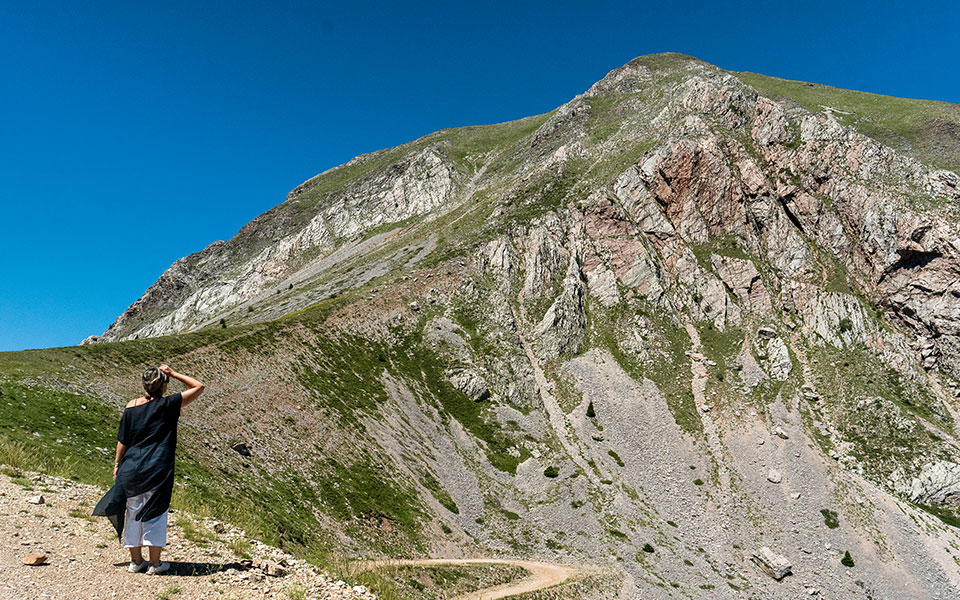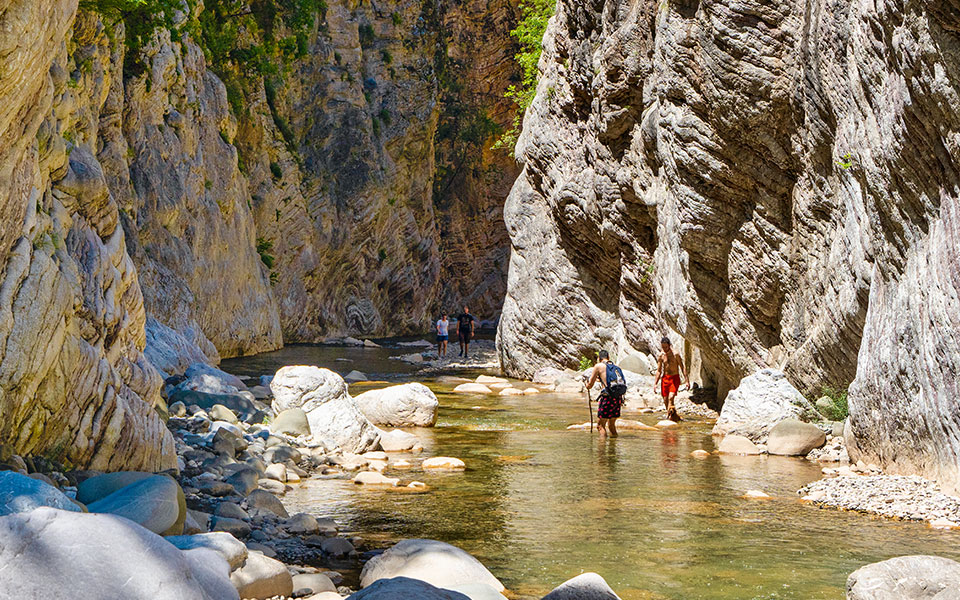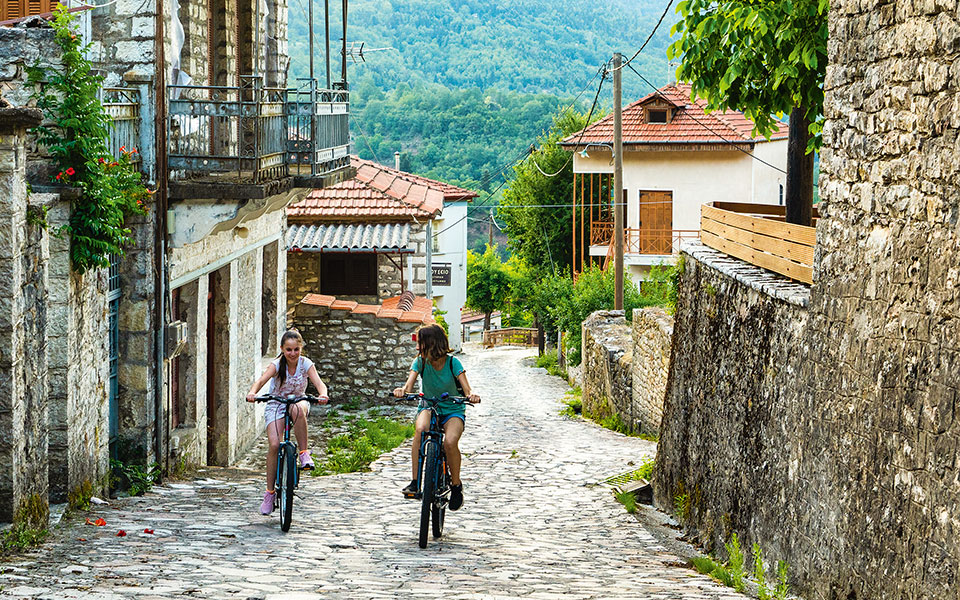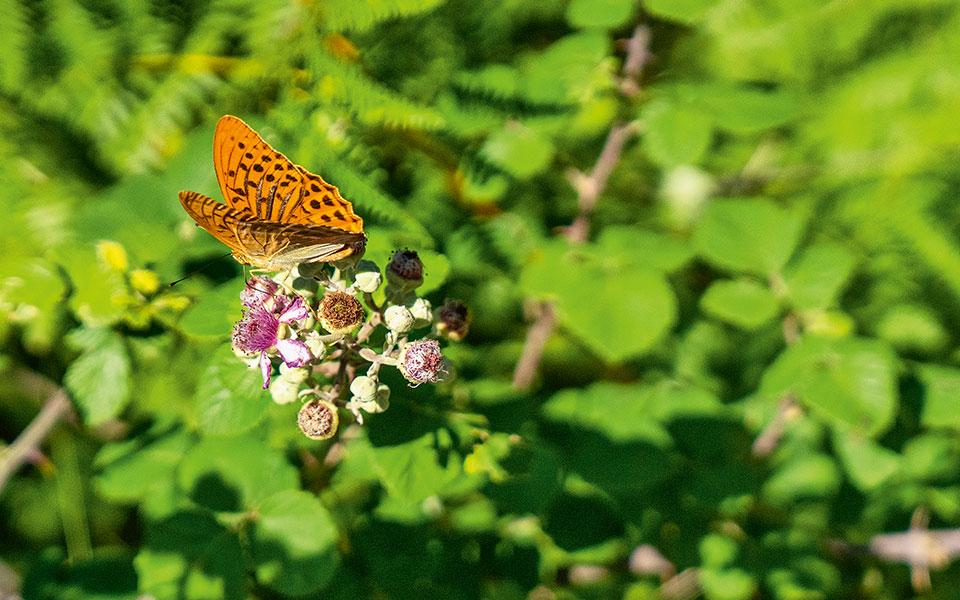Autumn Escapes to Greece’s Mountains and Lakes
When the summer crowds depart, Greece’s...

The watery curtains of Panta Vrechi (“Always Raining”) create a fairy tale setting. Water flows down from Mount Kaliakouda to create this unique phenomenon.
© Perikles Merakos
To the south of Karpenisi, between the mountains of Kaliakouda and Platanaki in the region of Evrytania, Central Greece, Panta Vrechi (which translates as “Always Raining”) is a rare gem of Greek nature. It is located in the magical gorge of Krikellopotamos (also known as Krikelliotis) and is its most famous – and narrowest – section.
To get there, you can either follow the Karpenisi-Megalo Chorio route, or the Karpenisi-Aniada route and then take the dirt road towards the Kaliakoudas pass (at 1,720 meters), to go downhill through the dense forest until you reach the village of Stournara (formerly Doliana). Around two and a half kilometers from the village, the dirt road meets the Krikellopotamos river course by a hanging bridge. From this point, the river trekking begins. You can also approach the same location via Domnista-Roskas.

Gazing on the summit of Kaliakouda.
© Perikles Merakos
Walking will take you over the pure white pebbles of the riverbed, with its brownish-green translucent waters. Soon the river enters the narrow gorge, and at times you will have to wade through waist-high water. Along the vertical faces of the gorge are grey and purple rock layers, while the steep slopes of the mountains higher up create narrow passages with very little light penetrating through, creating sublime images. Soon the light gets even weaker, small waterfalls flow down the northern slopes, and soon the phenomenon known as “Panta Vrechi” comes into view: a complex of small waterfalls cascading from caves and domes onto vines, wet plants and mosses which are always dripping. Further up, the roots of trees suspended above look like organic chandeliers dripping water.
The water flowing from Kaliakouda mountain like a constant drizzle has named this phenomenon “Panta Vrechi” (“Always Raining”). Forming waterfalls, when they reach this part of the gorge they branch off into countless little streams over the fissured rocks and vines, resulting in the scenic “rain” in Krikellopotamos gorge.
After Panta Vrechi the gorge remains narrow, but less dark, and the river passes through impressive straits with rocks carved by the water into sculptures. At some points you may have to swim a short distance. Along the way, the trail meets a concrete bridge without a trace of road. From here you can turn back following the same route past Panta Vrechi to the bridge below Stournara.
Alternatively, you can follow the trail to the abandoned village of Kontiva and return to Stournara by way of the mountains.

The route to Panta Vrechi through the Krikellopotamos gorge.
© Perikles Merakos

Megalo Chorio is perhaps the most developed village near Panta Vrechi. This is where the dirt roads to Kaliakouda and the Krikellopotamos valley begin.
© Perikles Merakos
The trek through the river offers many opportunities to stop and admire the beautiful scenery, however your longest stop will be at the falls at Panta Vrechi, where the waterfalls and the watery curtains run constantly for 100 meters or so of the gorge. You will also make a stop at the concrete bridge below Kontiva, to decide whether to double back or continue up the mountain (in a change of dry clothes).
Doliana was the most prosperous village in the area because of its plentiful water. During the Greek Civil War, the Democratic Army used the village as their headquarters, where they used to carry out two months of training before heading to the mountains. The locals say that Doliana was renamed Stournara after the martyr St Gerasimos from Megalo Chorio, whose name was Georgios Stournaras and whose parents hailed from Doliana. In the village of Stournara there is a beautiful little chapel dedicated to St Barbara, which dates to 1717.
The ruined castle in the village of Roska was, according to local tradition, the home of the queen Rousa or Rouska, who gave her name to the village. Another tradition has the queen having Russian roots, hence the name Roska. What is reality and what is legend? Whatever the case, the village name used to be spelt with an “omega,” while now it is written with an “omicron.”

Panta Vrechi and the Krikellopotamos gorge are a unique habitat hosting many animals, fish, and rare plants.
© Perikles Merakos
River trekking on the Kriekllopotamos on the section between Stournara bridge-Roskas-Panta Vrechi is suitable for walkers with moderate experience but is not suitable for small children. Traversing the gorge and returning to Stournara via Kontiva is for experienced climbers in good physical condition, as the trek takes several hours and has sections with steep changes in elevation.
Panta Vrechi should only be visited in the summer months up until September. For the rest of the year the waters of the Krikellopotamos swell and can be dangerous. You will need river trekking shoes as the pebbles can be very slippery, as well as a good waterproof pack with a change of dry clothes, bathing costumes, and a pair of dry shoes for the return.
The narrow trail towards Kontiva climbs through a dense oak forest. Kontiva (now known as Kontos) is one of those rare mountain villages that was never reached by a road. It has a few beautiful houses, an old church and a superb view of the surrounding gorges and mountains. The trail continues to the east, past the chapel of St George on the cliff, and ends up at Stournara.
A longer river canyoning route to Panta Vrechi starts from the Krikello-Domnista bridge. Following the river course, in one and a half hours you will pass Xerorema and after another hour you will pass the dirt road connecting Aghios Charalambos and Aniada. After two hours you will pass the Psianon-Kastanoulas bridge, and another hour and a half later you will reach the Roskas-Stournaras dirt road and the hanging bridge. From here you can continue on to Panta Vrechi.
The distance from the Stournara-Roskas bridge to the Kontiva bridge is around two kilometers. River trekking takes about one hour. The elevation changes are very minor (+50 m). If you decide to return to Stournara on the mountain route via Kontiva, allow yourself another four hours of walking.
When the summer crowds depart, Greece’s...
Without noise or concrete, the Old...
A brave history and uniquely beautiful...
One of the most rewarding road...